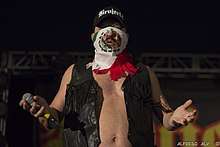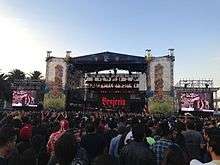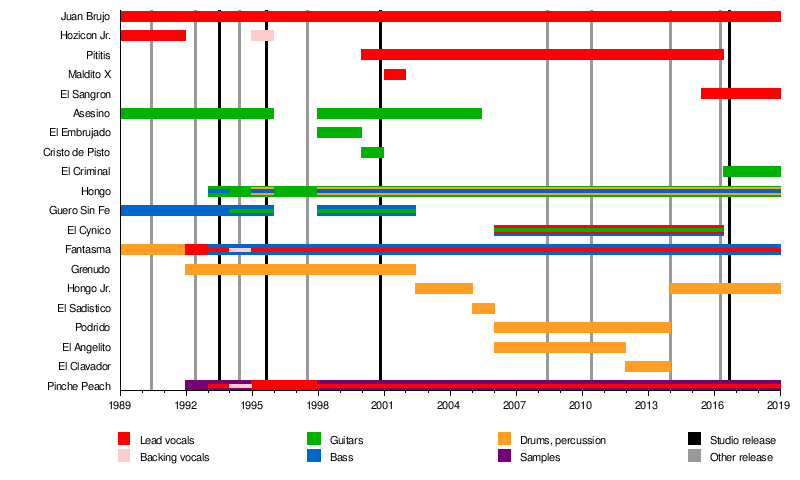Brujeria (band)
Brujeria (Spanish pronunciation: [bɾuxeˈɾi.a]) is an American[3] extreme metal band formed in Los Angeles, California in 1989. The band's name comes from the Spanish word for "witchcraft". Their songs, which are sung in Spanish, are focused on Satanism, anti-Christianity, sex, immigration, narcotics smuggling, and politics.[4] Portraying a Mexican image and with a heavy anti-American stance, the majority of the band's members are Mexican-born, with some being American, Swedish or British.
Brujeria | |
|---|---|
 Brujeria performing at the 2009 Sziget Festival | |
| Background information | |
| Origin | Los Angeles, California, U.S.[1][2] |
| Genres | |
| Years active | 1989–2002, 2007–present |
| Labels | |
| Website | brujeria.com |
| Members |
|
| Past members |
|
Brujeria alumni include Fear Factory guitarist Dino Cazares and drummer Raymond Herrera, as well as Billy Gould, Nicholas Barker, Jeff Walker and Shane Embury. They perform under pseudonyms and portray themselves as a Latino band consisting of drug lords, concealing their identities due to being wanted by the FBI. In videos and photographs of the band, they are shown wearing bandanas, balaclavas, serapes, and are often shown wielding machetes.[4]
History
Formation and early releases (1989–1992)
Brujeria was formed at a party in 1989 in the spirit of creating a grindcore and death metal band representative of the Latino/Chicano community. Its members, the guitarist Dino Cazares, Jello Biafra, drummer Pat Hoed, bass guitarist Billy Gould and vocalist Juan Brujo, used pseudonyms as most were in other known bands.
Their first single, "¡Demoniaco!", was released in 1990. In 1992 "Machetazos" was released and with it came the band's first line-up change. Jello Biafra departed the group, Pinche Peach [5] was introduced as an additional vocalist and Raymond Herrera took on the drums; Pat Hoed, the band's former drummer became a second vocalist. "Machetazos" and "El Patrón" (1994) were produced and distributed through Jello Biafra's record label Alternative Tentacles.[6]
The band was criticized from its inception for its lyrics about drugs, sex and Satanism. These topics, while the subjects of many other death metal acts, were inspired by the actions of Adolfo Constanzo, Cuban-American born Mexican drug smuggler, practitioner of Palo Mayombe, and serial killer.[7]
Matando Güeros and controversy (1993–1994)
Controversy was created by the cover of their first album Matando Güeros (1993), which featured a severed head being held by a hand. Subsequently, the image of the head would become an emblem of the band, transforming themselves into their mascot known as Coco Loco ("mad/crazy bogeyman" or "mad/crazy head" in Mexican slang), and is seen frequently on album covers and merchandise. The severed head is of a drug dealer in a photo taken from a Mexican publication.[8] This album saw the addition of Shane Embury on guitar and bass guitar.
Raza Odiada, Marijuana and Spanglish 101 (1995–1999)
In 1995 they released their second full-length Raza Odiada, with the usual themes but with significant changes in their music and for many critics and fans their best work to date. Raza Odiada featured the single "La Ley De Plomo", whose music video proved successful on music channels such as MTV, featuring late at night on heavy metal shows.
The group started to become increasingly popular, but nevertheless, decided to remain anonymous and declined all offers to organize concerts (except on rare occasions), confounding supporters, who were eager to see them live. Two years later came the EP Marijuana, featuring a cover-parody of the popular song "The Macarena" and four live songs from its first official concert.
1999 saw the release of Spanglish 101, a compilation of label Kool Arrow Records' artists, protesting against the dominance of English. On this album the band released a couple of new tracks: "Marcha de Odio" which would later be included in their next album, Brujerizmo and "Don Quijote Marijuana", an issue that attracted attention for its techno-dance style, completely different from the band's heavy metal sound.
Commercial success with Brujerizmo and Mextremist Hits! (2000–2001)
In 2000, 5 years after the last LP, Brujerizmo was released, which incorporated Nicholas Barker as a second drummer, Jesse Pintado on the guitar and Gaby Dominguez, as "Pititis", who represents a female demon[9] as the female vocalist.
The next release was a compilation, called Mextremist! Greatest Hits, released in 2001, which included classic tracks, alternate versions, remixes, a multimedia track with video, and some new themes, such as the collaboration with Mucho Muchacho on "Narco-Peda" and "Asesino" which featured Tony Campos of Static-X. The record, rather than being a compilation, was more like a disc of rarities and B-sides, since most of the songs were not the album versions, but the versions on the EPs and singles. The disc also included a video cover for the Magazine 60 song "Don Quichotte" named "Don Quijote Marihuana".
Hiatus and projects (2002–2006)
2002 came with many plans for the band, first they went to record new material for their eagerly awaited fourth album. However, this seems to have been put on hold due to altercations between Cazares and Herrera related to the temporary breakup Fear Factory. Herrera departed Brujeria in 2002, shortly before Fear Factory reformed without Cazares. The band then announced the launch of various side-projects for each of the band members, starting with Asesino who launched that same year, Corridos de Muerte with the band featuring Tony Campos and Emilio Marquez.
There is a DVD compilation of the band called "Permission of Satan". This DVD was produced by Juan Brujo and Henry about the recording period of the Asesino album and videos of his first three presentations of the official tour of Brujeria, The Mexecutioner Tour. Also includes images of the addition of Wee Man Jason Acuña of Jackass, Satanico Army Band, Mariachi Terror, and others. The DVD was homemade and distributed by Juan Brujo.
Brujeria declined to do live performances in its early years, however on June 11, 1997, they played at the Whisky a Go Go club in Hollywood. The short concert itself was incorporated into the EP "Marijuana" as a side B. On October 2, 2003, the band played its first official concert in Chicago, USA, and began its first tour known as The Mexecutioner Tour, which concluded on January 24, 2004 in Guadalajara, Mexico. Also in 2003, Roadrunner Records released a compilation of tracks from the studio albums, the band titled The Mexecutioner! - The Best of Brujeria. The band, now with Nicholas Barker on drums, decided to promote the work as the band had never done before, which included interviews, concerts and more. Starting with a second tour called "Tour II", which began on February 7, 2004, in Mexicali and the first appearance of Pititis the female voice of the band, their first visit to Brazil and Argentina, concluding the tour on August 8, 2004 in Buenos Aires.
After that the band was absent from the stage and uncertainty about the group's future arose, it was speculated that the reason for this was that they were working on a new album but none materialized. Also during this period of time several vital members of the group such as Dino Cazares, departed after alleged differences with frontman Juan Brujo. In 2006 there was news from the band with the release of The Singles which is a revival of the EP and singles of the band and the beginning of a new global concert tour known as "No Seas Pendejo Tour" that began in Buenos Aires, Argentina on January 28 and also included the presentation in Vive Latino 2006 in Mexico featuring two new members: Tony Laureano on drums and Jeff Walker on bass. Shane Embury left bass and switched to guitar. At their first appearance in Europe Viña Rock, Spain, the tour concluded on 6 August of that year in Houston, Texas. Later in September of that year they returned to do a small tour in Spain known as "Don Quijote Marijuana Tour" now with Patrik Jensen on guitar and Adrian Erlandsson on drums.
Reunion and Pocho Aztlan (2007–present)

After several years on hiatus, and internal problems, Brujeria reformed in 2007 and decided it was time to return to the scene. Juan Brujo (vocals), Pat Hoed (second vocals), Jeff Walker (bass), Shane Embury (guitar) and Adrian Erlandsson (drums) started a new tour called "Weapon of Change Tour". Lasting from February 21 to December 15, the band performed in England, Italy, Spain, France, Germany, the United States, Mexico, Colombia, Argentina, Brazil, Peru, Chile and Ecuador. Between April and June 2008, Brujeria returned to Europe to play some concerts as an extension of the "Weapon of Change Tour", including dates at SWR MetalFest XI in Barroselas (Portugal), again Viña Rock (Albacete, Spain)[10] and in Kobetasonik,[11] a rock festival that takes place in the Basque Country (Spain). In November and December of that year, the band began another tour called "Accept No Imitations Tour". Brujeria played at the 10th annual Maryland Death Fest in May 2012.
They performed a world tour between 2007 and 2008. In an interview in June 2009, bassist Shane Embury stated that the band's fourth studio album was going to be released that year, and that it could be released by the band itself.[12] On October 2014 they signed with indie giant Nuclear Blast for an album in 2015. On July 1, the band announced that they would finally release their fourth studio album Pocho Aztlan on September 16. The album is their first in sixteen years, and their first to feature Hongo Jr., El Cynico, El Sangron and Cuernito.[13]
Band members

Current
- Juan Brujo – lead vocals (1989–present)
- Fantasma – bass, vocals (1989–present)
- Hongo – bass, guitars (1989–present)
- Pinche Peach – samples, vocals (1989–present)
- El Sangrón – vocals (2014–present)
- El Criminal – guitars (2015–present)
- Hongo Jr. – drums (2002–2005, 2016–present)
- La Bruja Encabronada – vocals (2017–present)
Past
- Hozicón Jr. – additional vocals (1989–1992)
- Güero Sin Fe – bass (1989–2002)
- Asesino – guitars (1989–2005)
- Greñudo – drums (1993–2002)
- Cristo de Pisto – guitars (2000)
- Maldito X – vocals (2001)
- Pititis – guitars, vocals (2004–2016)
- El Cynico – bass, guitars, vocals (2006–2016)
- El Angelito – drums (2006)
- El Podrido – drums (2006–2014)
- El Clavador – drums (2012–2014)
Timeline

Discography
Full-length albums
| Year | Title | Label | Format | Other information |
|---|---|---|---|---|
| 1993 | Matando Güeros | Roadrunner | CD |
|
| 1995 | Raza Odiada | Roadrunner | CD | |
| 2000 | Brujerizmo | Roadrunner | CD | This is the last album recorded with the two original members, Asesino and Güero Sin Fe. |
| 2016 | Pocho Aztlan | Nuclear Blast | CD | This is the first album released on Nuclear Blast. This is also the band's first album in sixteen years, as well as its first release featuring El Cynico on bass. The album was released on September 16, 2016. |
Singles and EPs
- 1990 - ¡Demoniaco! (Nemesis Records)
- 1992 - ¡Machetazos! (Alternative Tentacles)
- 1994 - El Patrón (Alternative Tentacles)
- 2000 - Marijuana (Kool Arrow Records)
- 2008 - Debilador (Independent)
- 2009 - No Aceptan Imitaciones (Independent)
- 2010 - California Uber Aztlan (Independent)
- 2014 - Angel Chilango (Independent)
- 2016 - Viva Presidente Trump! (Nuclear Blast)
- 2019 - Amaricon Czar (Nuclear Blast)
Compilation albums
- 1994 - Best of Grindcore and Destruction (Priority Records)
- 1996 - At Deaths Door II
- 1999 - Spanglish 101 (Kool Arrow Records)
- 2001 - Mextremist! Greatest Hits (Kool Arrow Records)
- 2003 - The Mexecutioner! - The Best of Brujeria (Roadrunner Records)
- 2006 - The Singles
See also
- Adolfo Constanzo, leader of a true-life Mexican murder cult who profited by drug smuggling
- Borderland, a 2007 film based on Constanzo and his cult
References
- "Brujeria - Grindcore/Death metal band from Mexico". Tartarean Desire. Retrieved 2012-08-22.
- "American Studies Journal - Brujeria and the U.S.-Mexico Border Outlaw". Asjournal.zusas.uni-halle.de. Archived from the original on 2012-06-28. Retrieved 2012-08-22.
- "Artists :: BRUJERIA". MusicMight. Archived from the original on 2012-10-07. Retrieved 2012-08-22.
- "Thrasher Skateboard Magazine | Brujeria". Thrashermagazine.com. 2010-08-26. Retrieved 2012-08-22.
- "Pinche Peach". Metal-archives.com. Retrieved 16 November 2014.
- Giant Robot 2004 - ... impossible-to-understand Cookie Monster vocals, you can actually hear the lyrics of Brujeria songs like "Mantando Gueros" (killing white guys), "Molestando Ninos Muertos" (molesting dead children), and "El Patron" (dedicated to Columbian ... Pablo Escobar"
- "Adolfo Constanzo Biography". Biography.com. Archived from the original on 29 November 2014. Retrieved 16 November 2014.
- Patti Muck (1996-10-16). "Murder clue could be a CD cover". Houston Chronicle. Retrieved 2017-04-24.
- "Bands". Alternative Tentacles. 1993-12-07. Archived from the original on 2011-11-10. Retrieved 2012-08-22.
- "Concert News/Conceirtos Noticias". Brujeria.com. Archived from the original on 2013-02-08. Retrieved 2011-11-02.
- "KOBETASONIK. Crítica 2008". INFOROCK.net. Retrieved 16 November 2014.
- "NAPALM DEATH's EMBURY Discusses Upcoming BRUJERIA Album". Roadrunnerrecords.com. Archived from the original on 2009-06-15. Retrieved 2011-11-02.
- "BRUJERIA To Release 'Pocho Aztlan' Album In September". blabbermouth.net. Retrieved 2016-07-01.
External links
| Wikimedia Commons has media related to Brujeria. |
- Official website
- Brujeria at Allmusic.
- Brujería discography at MusicBrainz